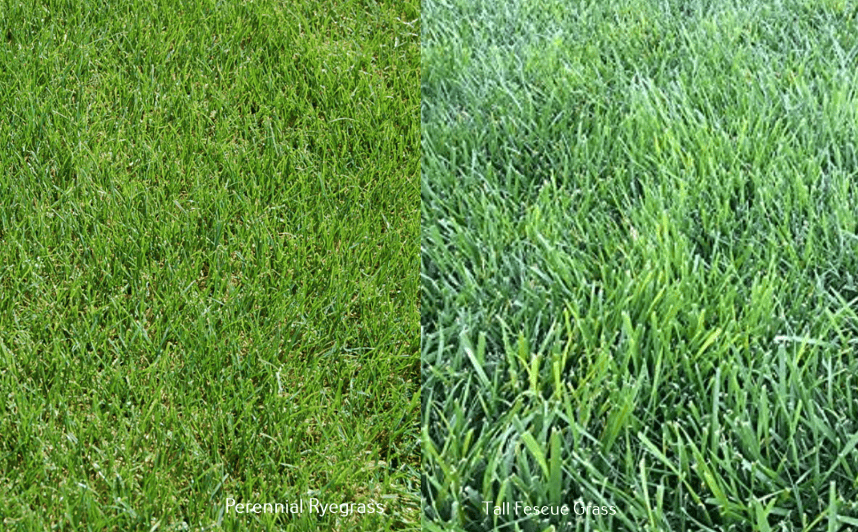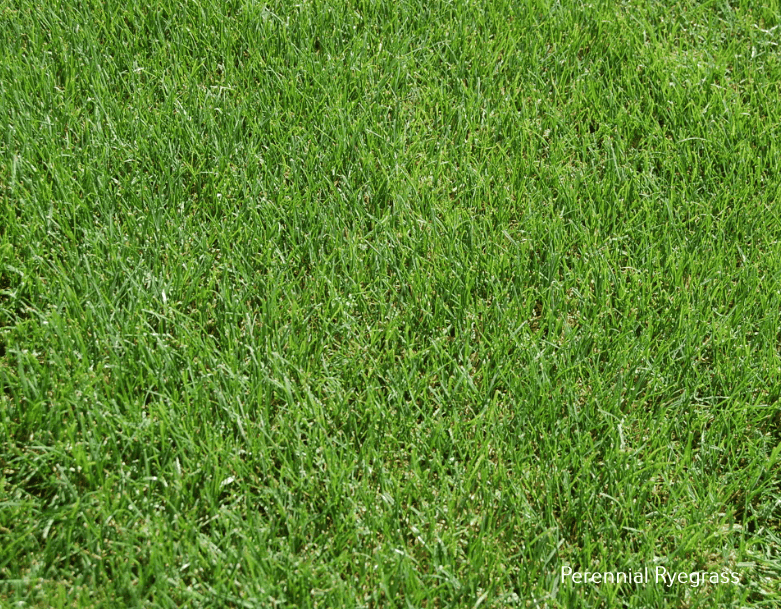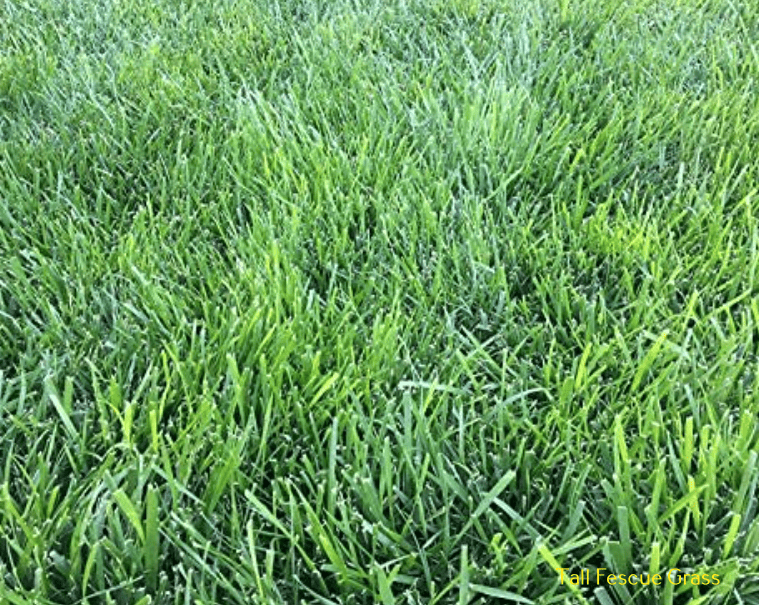Are you thinking of starting a lawn or changing your lawn grass, and you are having difficulty deciding between perennial ryegrass and tall fescue? Both are tough turf grown in cool climates and transition areas. However, they have notable differences, such as shade tolerance, wear tolerance, and soil type preference which are helpful in making a choice.
Here is a summary of the key differences between perennial ryegrass and tall fescue:
| Perennial Ryegrass | Tall Fescue |
| A fine textured bright green grass. | A coarse-textured dark green turf. |
| Shallow-rooted grass with limited tolerance to drought and heat. | Deep-rooted grass that has good tolerance to drought and heat. |
| It has the highest wear tolerance and is thus suitable for high-traffic areas. | It has moderate wear tolerance and is also still suitable for high-traffic areas. |
| The grass prefers well-draining soil to thrive. | The grass can effectively thrive in clay and compacted soils. |
| The grass thrives in full sun and a temperature of 75°F | The grass has good shade tolerance and prefers a temperature of 70°F. |
| It needs high maintenance that includes mowing, watering, and fertilizing | Low-maintenance turf with less need for watering, mowing and fertilizing |
| Quick to germinate – 5 to 7 days, thus suitable for overseeding a warm season lawn | Takes more time to germinate – 7 to 21 days |

Perennial Ryegrass vs. Tall Fescue – Differences
In detail, the following are the main differences between Perennial Ryegrass and Tall Fescue grass.
1. Identification
Perennial Ryegrass is a fine textured bright green grass with a leaf folded in the bud. It is a cool season grass grown as forage, turf grass, and cover crop. The grass thrives in moderate summer and cool winter. It prefers full sun but can tolerate partial shade.
It is grown as a permanent lawn in cooler and transition regions and a temporary lawn in warm areas. Homeowners in warm areas that love having a green lawn all year round usually overseed their warm season lawn with perennial Ryegrass so that when the lawn goes dormant during winter, the perennial ryegrass can take over.

Tall Fescue is a breed of fescue grass that is a cool season grass with coarse dark green blades. It is a bunch-type grass that grows in clumps and spreads through tillers. It spreads slower than grasses that spread through rhizomes and stolons and, therefore, will take more time before filling a lawn. See how to make tall fescue grass spread fast.

2. Drought and heat tolerance
Traditional perennial Ryegrass varieties are shallow-rooted, which limits their ability to tolerate drought or heat. However, the improved varieties can tolerate drought and heat better and require 30% less water when established than the traditional varieties.
Tall Fescue is deep-rooted, allowing it to reach deeper for water and nutrients than most grasses. The deep roots enable it to thrive with limited water, as they can draw moisture from the soil. For routine maintenance, tall Fescue requires 1 inch of water a week but should be increased to 1.5 inches during summer.
Both types of grass should be maintained at 3-4 inches of water during summer to conserve moisture.
3. Traffic and wear tolerance
Perennial Ryegrass has the highest wear tolerance among cool-season grasses. It also has a high traffic tolerance; hence, you will find it in high-traffic areas such as parks, school fields, and golf courses.
On the other hand, Tall Fescue has moderate wear tolerance, although it can withstand high traffic, and you will also find it in high-traffic areas. However, tall fescue can take more abuse than perennial Ryegrass making it more suitable for a lawn with pets.
4. Soil type and PH
Tall fescue thrives in rich clay soil with a pH of 5.5 – 7.5. It is very hardy as its deep, strong roots can penetrate moderately compacted soil.
Perennial Ryegrass has shallow delicate roots compared to fescue. They cannot penetrate through compacted soil and will establish close to the soil surface. The grass loves dry well-draining soil and a pH of 5.5 – 7.5.
5. Temperature requirements and shade tolerance
Perennial Ryegrass thrives at a temperature of 75°F and will go dormant at 55°F. Tall fescue grows best at 70°F and goes dormant at 50°F.
Perennial ryegrass prefers full sun, but some cultivars can tolerate partial shade as long as they get sun for 4-5 hours. Tall fescue has good shade tolerance and is one of the best grass to grow under trees.
6. Mowing Height
Both types of grasses should be mowed once a week during the cool season and twice a month during summer. Perennial ryegrass should be kept at the height of 1.5-2.5 inches, while tall fescue should be maintained at 2 inches during the cool season and 3-4 inches during summer to cover the roots from the sun.
7. Diseases and pests
Perennial ryegrass is susceptible to lawn diseases such as snow molds, powdery mildew, ergot, leaf spot, and brown blight. It is also affected by pests such as Argentine stem weevils and grubs.
Tall fescue has moderate disease resistance but is still vulnerable to fusarium blight, brown patches, and leaf spots. It is also sometimes infested by pests such as white grubs and armyworms.
Which is better, Ryegrass or fescue?
To understand better and make a wise between the two turf types of grass, let’s have a look at their pros and cons:
Pros of Ryegrass
Ryegrass has the following advantages
- Quick to germinate – perennial ryegrass is loved because it takes 3-5 days to sprout compared to other grasses like Kentucky bluegrass, which takes up to 21 days. The short time it takes to germinate makes it a perfect choice to overseed a warm climate lawn to retain the green colour even after the lawn grass dries.
- High wear and traffic tolerance make it ideal for high-traffic lawns.
- Moderate disease and insect resistance.
- It can be used for permanent and temporary lawns.
Cons of perennial ryegrass
Ryegrass has the following negatives
- It grows in clumps and therefore does not spread on its own. It needs to be overseeded to cover bare patches.
- It struggles to thrive under shade as it prefers full sun.
- It cannot tolerate extreme cold and is not ideal for far-north lawns.
- High maintenance is needed for mowing, watering, and fertilization.
Pros of Tall Fescue
Tall fescue grass has the following strengths
- Excellent heat and cold tolerance.
- Its deep roots make it drought tolerant as they can draw moisture deep from the soil.
- The deep roots also draw nutrients from the soil, minimizing the need for fertilizer.
- Has a high shade tolerance.
- It has a high traffic tolerance.
- It can grow in various climates.
- First growth rate after sprouting – tall fescue can grow up to 2 inches a week during its peak season.
- Moderate disease resistance
Cons of Tall fescue
Tall fescue has this disadvantage;
It’s a bunch type of grass that spreads through tillers – it cannot spread to fill bare patches meaning overseeding is needed.
Can you mix tall fescue and perennial ryegrass?
Since ryegrass germinates and establishes more quickly than tall fescue, they can be mixed to establish a lawn quicker. However, since they are both cool-season grasses, the mix will not work for a warm region or an area that experiences extreme winter as ryegrass will die.
Also, depending on the type of lawn you want, check the mix ratio, as ryegrass might take over the lawn since it will establish faster. However, mixing the two will give a beautiful blended lawn for a region with cool winters and a shady lawn.
Also Check: Perennial Ryegrass vs Annual Ryegrass
My Take
Both perennial ryegrass and tall fescue are cool-season grasses that thrive in similar conditions. However, tall fescue is deep-rooted, giving it an upper hand in drought resistance and wear tolerance. It also has a higher tolerance for shade and cold.
Perennial ryegrass germinates and establishes faster and also has high traffic tolerance. However, it will go dormant in extreme heat or cold. Mixing perennial ryegrass and tall fescue will enable establishing a lawn faster but is only ideal for areas that experience moderate winter.